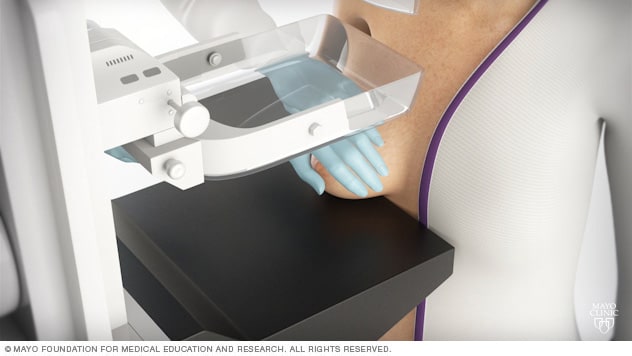Mammogram
![]() November, 20th, 2024
November, 20th, 2024
Summary
Learn what to expect during a breast X-ray exam. Find out about the benefits of mammograms for breast cancer screening, as well as potential risks.
Overview
, Overview, ,
A mammogram is an X-ray image of your breasts. It can be used either for breast cancer screening or for diagnostic purposes, such as to investigate symptoms or unusual findings on another imaging test.
During a mammogram, your breasts are compressed between two firm surfaces to spread out the breast tissue. Then an X-ray captures black-and-white images that are displayed on a computer screen and examined for signs of cancer.
Mammograms play a key role in breast cancer screening. They can detect breast cancer before it causes signs and symptoms. Mammograms have been shown to reduce the risk of dying of breast cancer.
A traditional mammogram creates two-dimensional images of the breast. A newer type of mammogram called a 3D mammogram (breast tomosynthesis) creates three-dimensional images of the breast. Many medical facilities offer the 3D mammogram in addition to the traditional 2D mammogram for breast cancer screening.

During a mammogram, you stand in front of an X-ray machine designed for mammography. A technician places your breast on a platform and positions the platform to match your height. The technician helps you position your head, arms and torso to allow an unobstructed view of your breast.
Receiving a mammogram Why it’s done
Mammograms are X-ray images of your breasts designed to detect cancers and other changes in breast tissue. A mammogram can be used either for screening or for diagnostic purposes:
-
Screening mammogram. A screening mammogram is used to detect breast changes that could be cancerous in people who have no signs or symptoms. The goal is to detect cancer when it’s small and treatment may be less invasive.
Experts and medical organizations don’t agree on when to begin regular mammograms or how often the tests should be repeated. Talk with your health care provider about your risk factors, your preferences, and the benefits and risks of screening. Together, you can decide what screening mammography schedule is best for you.
- Diagnostic mammogram. A diagnostic mammogram is used to investigate suspicious breast changes, such as a new breast lump, breast pain, an unusual skin appearance, nipple thickening or nipple discharge. It’s also used to evaluate unexpected findings on a screening mammogram. A diagnostic mammogram includes additional mammogram images.
Risks
Risks and limitations of mammograms include:
- Mammograms expose you to low-dose radiation. The dose is very low, though, and for most people the benefits of regular mammograms outweigh the risks posed by this amount of radiation.
-
Having a mammogram may lead to additional testing. If something unexpected is detected on your mammogram, you may need other tests. These might include additional imaging tests such as ultrasound, and a procedure (biopsy) to remove a sample of breast tissue for laboratory testing. However, most findings detected on mammograms aren’t cancer.
If your mammogram detects something unusual, the doctor who interprets the images (radiologist) will want to compare it with previous mammograms. If you have had mammograms performed elsewhere, your radiologist will ask for your permission to request them from your previous health care providers.
- Screening mammography can’t detect all cancers. Some cancers detected by physical examination may not be seen on the mammogram. A cancer may be missed if it’s too small or is located in an area that is difficult to view by mammography, such as your armpit.
- Not all of the cancers found by mammography can be cured. Some breast cancers are aggressive, grow rapidly and quickly spread to other parts of the body.
How you prepare
To prepare for your mammogram:
- Schedule the test for a time when your breasts are least likely to be tender. If you menstruate, that’s usually during the week after your menstrual period.
- Bring your prior mammogram images. If you’re going to a new facility for your mammogram, request to have any prior mammograms placed on a CD. Bring the CD with you to your appointment so that the radiologist can compare past mammograms with your new images.
- Don’t use deodorant before your mammogram. Avoid using deodorants, antiperspirants, powders, lotions, creams or perfumes under your arms or on your breasts. Metallic particles in powders and deodorants could be visible on your mammogram and cause confusion.
What you can expect
During the test
At the testing facility, you’re given a gown and asked to remove neck jewelry and clothing from the waist up.
For the procedure itself, you stand in front of an X-ray machine specially designed for mammography. A member of your health care team places one of your breasts on a platform and raises or lowers the platform to match your height. Your head, arms and torso are positioned in order to allow an unobstructed view of your breast.
Your breast is gradually pressed against the platform by a clear plastic plate. Pressure is applied for a few seconds to spread out the breast tissue. The pressure isn’t harmful, but it can cause some discomfort. Tell your health care team if the discomfort becomes too much.
Your breast must be compressed to even out its thickness and permit the X-rays to penetrate the breast tissue. The pressure also holds your breast still to decrease blurring from movement and minimizes the dose of radiation needed. During the brief X-ray exposure, you’ll be asked to stand still and hold your breath.
After the test
After images are made of both your breasts, you may be asked to wait while your care team checks the quality of the images. If the views are inadequate for technical reasons, you may have to repeat part of the test. The entire procedure usually takes less than 30 minutes. Afterward, you may dress and resume your usual activities.
Results
Mammography produces mammograms — black-and-white images of your breast tissue. Mammograms are digital images that appear on a computer screen. A doctor who specializes in interpreting imaging tests (radiologist) examines the images.
The radiologist looks for evidence of cancer and other conditions that may require further testing, follow-up or treatment. The results are compiled in a report and provided to your health care provider. Ask your provider when and how the results will be shared with you.
© 1998-2025 Mayo Foundation for Medical Education and Research (MFMER). All rights reserved. Terms of Use



